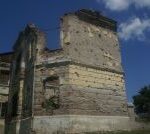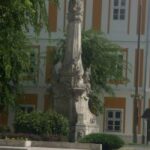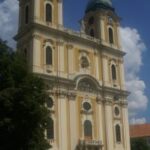Reminiscences 2024

 One of the miracles to me of World War II was the creation of a south Slav kingdom in the Balkans, replacing one of the tinder boxes that had triggered wars before erupting in World War I. But that had blown up in the ethnic rivalries after the death of Tito, and the bitter fighting of 1991-1995 could be seen in several towns
One of the miracles to me of World War II was the creation of a south Slav kingdom in the Balkans, replacing one of the tinder boxes that had triggered wars before erupting in World War I. But that had blown up in the ethnic rivalries after the death of Tito, and the bitter fighting of 1991-1995 could be seen in several towns 
 along the river. Our first stop in Croatia was Osijek, as in so many Danubian towns, a one-time Roman colony. The current town began around the 12th century, and was occupied by the Turks for over 150 years. Austrian authorities built a fortress, Tvrda, that is still one of the landmarks
along the river. Our first stop in Croatia was Osijek, as in so many Danubian towns, a one-time Roman colony. The current town began around the 12th century, and was occupied by the Turks for over 150 years. Austrian authorities built a fortress, Tvrda, that is still one of the landmarks  of the town of about 100,000. Baroque churches, a town square, a monument of gratitude for ending the plague–checks all the boxes. Croatian Serbian tensions led to Croatia siding with the Nazis.
of the town of about 100,000. Baroque churches, a town square, a monument of gratitude for ending the plague–checks all the boxes. Croatian Serbian tensions led to Croatia siding with the Nazis.
Belgrade, capital of Serbia, and one of the most  continuously occupied cities in Europe was our next stop. The city of over one million changed hands
continuously occupied cities in Europe was our next stop. The city of over one million changed hands between Rome, Byzantium, the Frankish kingdom, Bulgarian Kingdom, and the Ottomans. The Serbian Revolution led to independence by 1841. Because of Belgrade’s strategic location, the city has been in 115 wars, razed 44 times, bombed 5 times and besieged many times, according to Wikipedia. One of those five times was the 1999 “accident” when the Americans strafed the Chinese embassy. Amazing
between Rome, Byzantium, the Frankish kingdom, Bulgarian Kingdom, and the Ottomans. The Serbian Revolution led to independence by 1841. Because of Belgrade’s strategic location, the city has been in 115 wars, razed 44 times, bombed 5 times and besieged many times, according to Wikipedia. One of those five times was the 1999 “accident” when the Americans strafed the Chinese embassy. Amazing 
 anything is left. The synagogue dates from the 1920s, and the major Serbian Orthodox Church, St. Stava, begun in the 1930s, was not completed until the 1980s. Still, I overlooked the Sava River where the guns of August (1914) began World War I.
anything is left. The synagogue dates from the 1920s, and the major Serbian Orthodox Church, St. Stava, begun in the 1930s, was not completed until the 1980s. Still, I overlooked the Sava River where the guns of August (1914) began World War I.